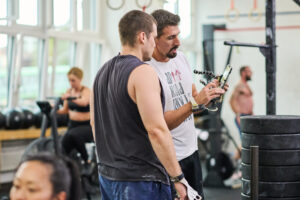
When you’re going through hormonal changes, the best workout for menopause isn’t a gentle suggestion—it’s a strategic decision that can improve your weight, mood, sleep, and long-term health.
Many women in their 40s and 50s feel like their bodies suddenly aren’t playing by the same rules: weight gain, brain fog, low energy, disrupted sleep, and mood swings become regular guests. If you’ve tried “moving more” but haven’t seen results, it’s time to upgrade your approach.
So, what really is the best workout for menopause?
Why strength training is essential during menopause
As estrogen declines, your body naturally begins to lose muscle and gain fat—particularly around the belly. This drop in muscle mass slows your metabolism and affects your insulin sensitivity, posture, and strength.
Strength training helps preserve and build lean muscle, which boosts your resting metabolism and protects against the natural loss of bone density that occurs in midlife. It also reduces the risk of osteoporosis, supports better balance and coordination, and helps prevent future injuries.
If you’re not lifting weights by the time you reach menopause, now is the time to start.
The best workout for menopause includes cardio—but not the old kind
Cardiovascular exercise is still important during and after menopause, especially for heart health, energy, and insulin management. But that doesn’t mean you need long, slow sessions on the treadmill.
The more effective approach? High intensity training (HIT)—short bursts of effort followed by rest. It improves cardiovascular endurance, hormone regulation, and metabolic health, all in less time.
High intensity workouts also increase post-exercise oxygen consumption, meaning your body keeps burning calories well after your session is over.
Many women are surprised to learn that the best workout for menopause isn’t slow and steady—it’s a smart mix of strength and intensity. Training like this helps reverse the muscle loss and metabolic slowdown that come with hormonal changes. It also improves how your body handles stress and blood sugar, two areas that often become harder to manage in midlife. Whether you’re brand new to fitness or coming back after a break, starting the right way matters. The best workout for menopause is one that’s safe, effective, and built to evolve with your needs over time.
Say goodbye to the apple shape: how to reduce menopause belly fat
One of the most common and frustrating changes women experience during menopause is the shift toward an “apple-shaped” body—where fat accumulates around the belly. This isn’t just a cosmetic issue. The fat stored deep inside the abdomen is called visceral fat, and it wraps around vital organs like the liver, pancreas, and intestines.
Visceral fat is metabolically active and contributes to increased risk of heart disease, type 2 diabetes, and chronic inflammation. Even women who appear slim can carry high amounts of visceral fat—so it’s important to measure body composition, not just track weight. Tools like an InBody scan can show exactly what’s happening under the surface.
The good news? You don’t need to accept this change as inevitable. The best workout for menopause—a combination of strength training and high intensity intervals—is one of the most effective ways to target and reduce visceral fat.
High intensity training helps regulate insulin, boosts metabolism, and stimulates fat burn—especially in the abdominal area. With consistent training and proper nutrition, women can not only lose belly fat but also lower health risks and feel stronger and more confident in their bodies.
Why CrossFit works so well for women in midlife
Here’s where it all comes together: CrossFit combines strength training and high intensity intervals in one efficient, coach-led session. That makes it not just a good option—but one of the best workouts for menopause.
And no, you don’t need to be “fit first.” Every workout can be adapted to your current fitness level. At our gym, workouts are:
- Measurable – so you can track real progress
- Safe – because all sessions are coached
- Scalable – every movement can be modified to meet you where you are
We train a diverse adult population, including many women navigating menopause. They come to feel stronger, more energized, and more in control—not just physically, but mentally too.
The best workout for menopause: key benefits
- Combats weight gain and low muscle tone
High intensity strength training helps maintain muscle, burns fat, and keeps your metabolism active—critical when hormones are shifting. - Protects your bones
Menopause speeds up bone loss. Lifting weights and performing impact-based movements signal your body to rebuild stronger bones. - Boosts energy and mood
Exercise releases endorphins, lowers cortisol, and improves your mental resilience—all things that can feel off-balance during menopause. - Improves sleep
Quality workouts help regulate your internal clock and reduce nighttime wake-ups. Just avoid intense training too close to bedtime. - Supports long-term health
The best workout for menopause is one you can stick with—because it helps with blood pressure, heart health, insulin sensitivity, and confidence.
How often should you train?
For most women, 2–3 CrossFit-style sessions per week—combining strength and high intensity intervals—is ideal. You can add walks, gentle movement, or recovery activities on other days.
Don’t worry about doing more. Focus on doing it right, with smart programming and proper rest.
Ready to feel strong, capable, and in control again?
You don’t need to accept menopause symptoms as the new normal. With the right training—built around strength, intensity, and coaching—you can thrive in your 40s, 50s, and beyond.
If you’re ready to try the best workout for menopause, we’re here to guide you every step of the way.




